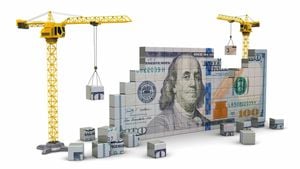Hurricane Milton recently made headlines for causing devastating changes along Florida's coastline, and the aftermath is nothing short of jarring. Satellite images reveal shocking transformations of iconic beaches like Sanibel and Captiva Islands, with some parts even being split in half due to the storm's fierce winds and relentless waves.
On October 10, 2024, Hurricane Milton roared onto Florida's western coast, bringing with it wind gusts of up to 100 mph and torrential rainfall, inundated coastal towns. The strong winds and flooding forced residents to evacuate, creating what some locals described as chaos. Thenewly revealed coastlines highlight how the storm has not only battered coastal destinations but also uprooted the delicate ecosystems along the state's shores.
Fox Forecast Center meteorologist Cody Braud weighed in on the startling aftermath. “Storms like Milton are pushing sand and water much farther inland than usual. And with so much storm surge, when things begin to recede, the reverse action pushes everything back out,” he explained. Satellite images showing plumes of brown and white along Sanibel Island's shoreline, are estimates of sand, dirt, and sediment returning to the Gulf of Mexico. He reassured viewers, noting, "The brown hues we see after the storm are expected. It just shows the massive amount of earth being moved around during these powerful storms."
Yet, stunning images reveal more than just sand and surf; they depict the erosion suffered by Florida's beaches. The loss of grains may appear minor to some but leads to severe coastal changes and heightened flood risks. Experts from the U.S. Geological Survey have issued stern warnings, stating, “This is the most severe level of coastal change,” emphasizing concerns the storm could cause erosion and overwash on virtually all of the state’s beaches. The turmoil faced by communities like Sanibel isn’t new, as they have experienced similar devastation from previous hurricanes, including Ian and Irma.
The damage doesn’t just stop at the beaches. The Canaveral National Seashore, stretched across nearly 58,000 acres, has been severely impacted. Officials have closed the site indefinitely as park management assesses dune erosion, extensive flooding, and damage to facilities. With heavy sand deposits blanketing roads and threats from upland flooding to comfort stations, the park's lifeblood — its trails and beaches — remains closed to the public until repairs can prove effective.
Privately, many Florida residents expressed their frustration and anxiety about what this means for their homes, lives, and routines. Repairing damage to structures will take time, money, and resources they may not have, and the mental toll looms heavy. According to reports, residents are experiencing heightened stress levels from repeated hurricane impacts. Many find themselves caught up in the chaos of recovery efforts, flooded homes, and the anxiety of what the next storm may bring.
Florida Governor Ron DeSantis has stepped forward, stating efforts are underway to assist residents. Notably, his administration launched initiatives to provide free fuel to those impacted by the hurricane. "We have opened 12 public fuel depot locations, where residents can get up to 10 gallons for their vehicles free of charge," he declared during his press conference, noting how more than 2,500 fuel trucks have been dispatched to restock the state’s fuel supply since the storm’s landfall.
While many residents are thankful for what support becomes available, some contemplate whether it will truly suffice. The scale of destruction wrought by Hurricane Milton feels overwhelming, marking yet another challenge for those who call Florida home. Questions abound: How long until the beaches are restored? Will residents bounce back from this storm's impact? Time will tell, but for now, Floridians face uncertainty as they begin to reckon with the powerful forces of nature against their beloved coastal landscapes.
The coast could experience more shifts, as recovery from natural disasters rarely follows a straight path. Environmental restoration efforts will be challenging, but they are necessary if Florida is to find stability and resilience. Experts predict back-to-back storms such as Milton and Helene will only continue to erode Florida's ecosystem over time.
Local businesses and tourism industries are also feeling the quake of Hurricane Milton's repercussions. With many beaches closed indefinitely and visitors diverted to safer locales, financial consequences loom large. The plight of individuals and businesses intertwined with coastal living remains precarious as they try to steer their existence back on course.
Observing the damage alongside personal stories of resilience lifts the curtains on the emotional gravity this storm imbued upon local communities. Individuals lost not just homes and belongings but also memories attached to beloved seaside spots still shaken by nature's force. It’s heartbreaking to realize how some elements of Florida's synergy with the sea may disappear entirely if storms become frequent visitors.
Recovering parts of Florida's impacted regions will require not just cleaning up but rethinking how they interact with their natural surroundings. With climate change adding more fuel to the fire of increasingly powerful storms, residents must adapt to the shifting reality along the coastline. This tumultuous time could act as a catalyst for rebuilding infrastructural and environmental safeguards. All bets are off, and careful observation of developing storms may be the saving grace for many families as they navigate both seasonal ebbs and flows of the waters around them and personal losses impacted by relentless weather.
For now, amid uncertainty and fear, it’s the spirit of community working together to rebound from Hurricane Milton’s wake, helping restore order wherever possible. Each house restored, every piece of sand placed back on the beach symbolizes resilience and hope. Floridians are not just battling weather patterns but redefining what survival means on the land they call home — through environmental shifts, financial pressures, and most prominently, emotional recovery.



